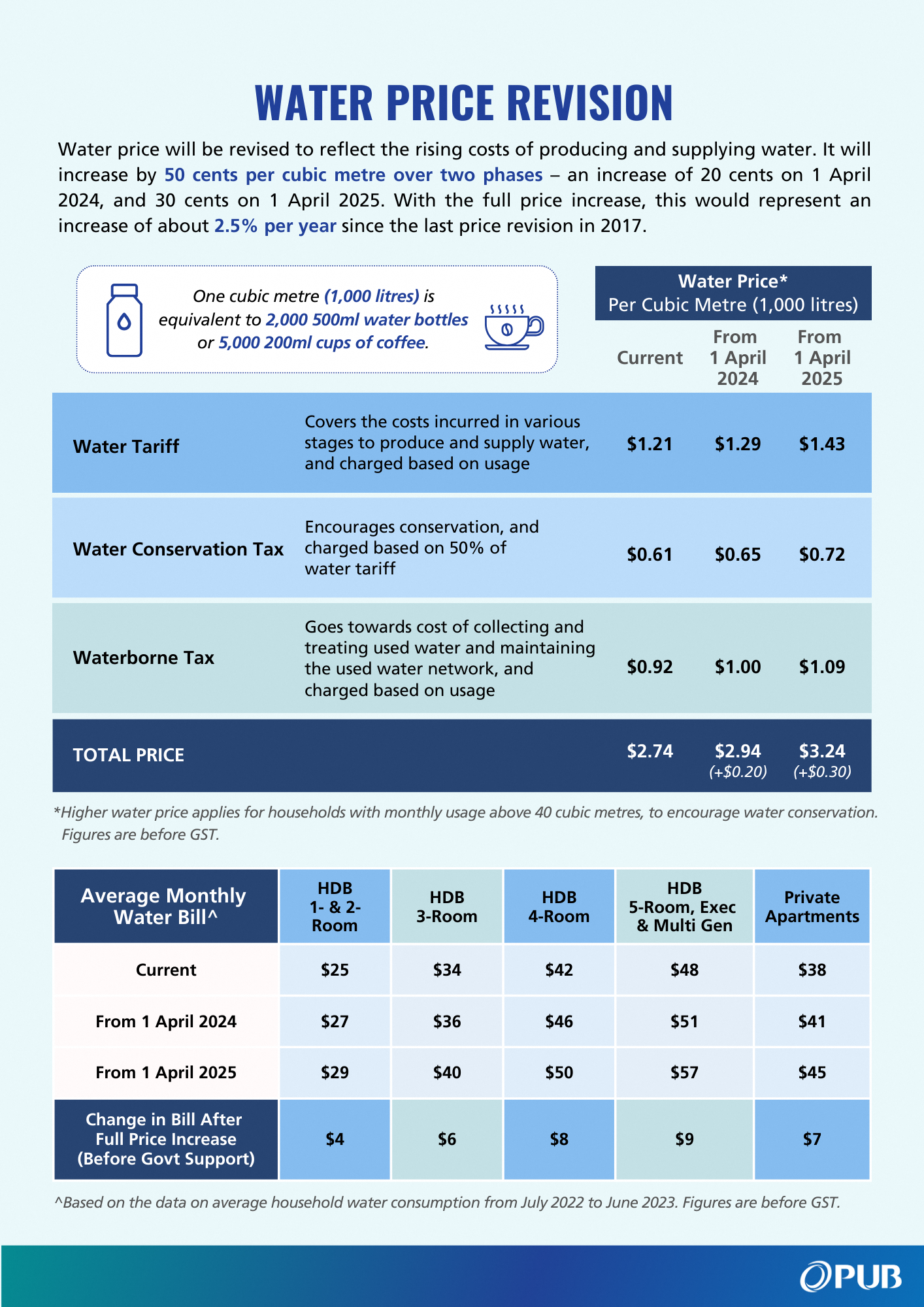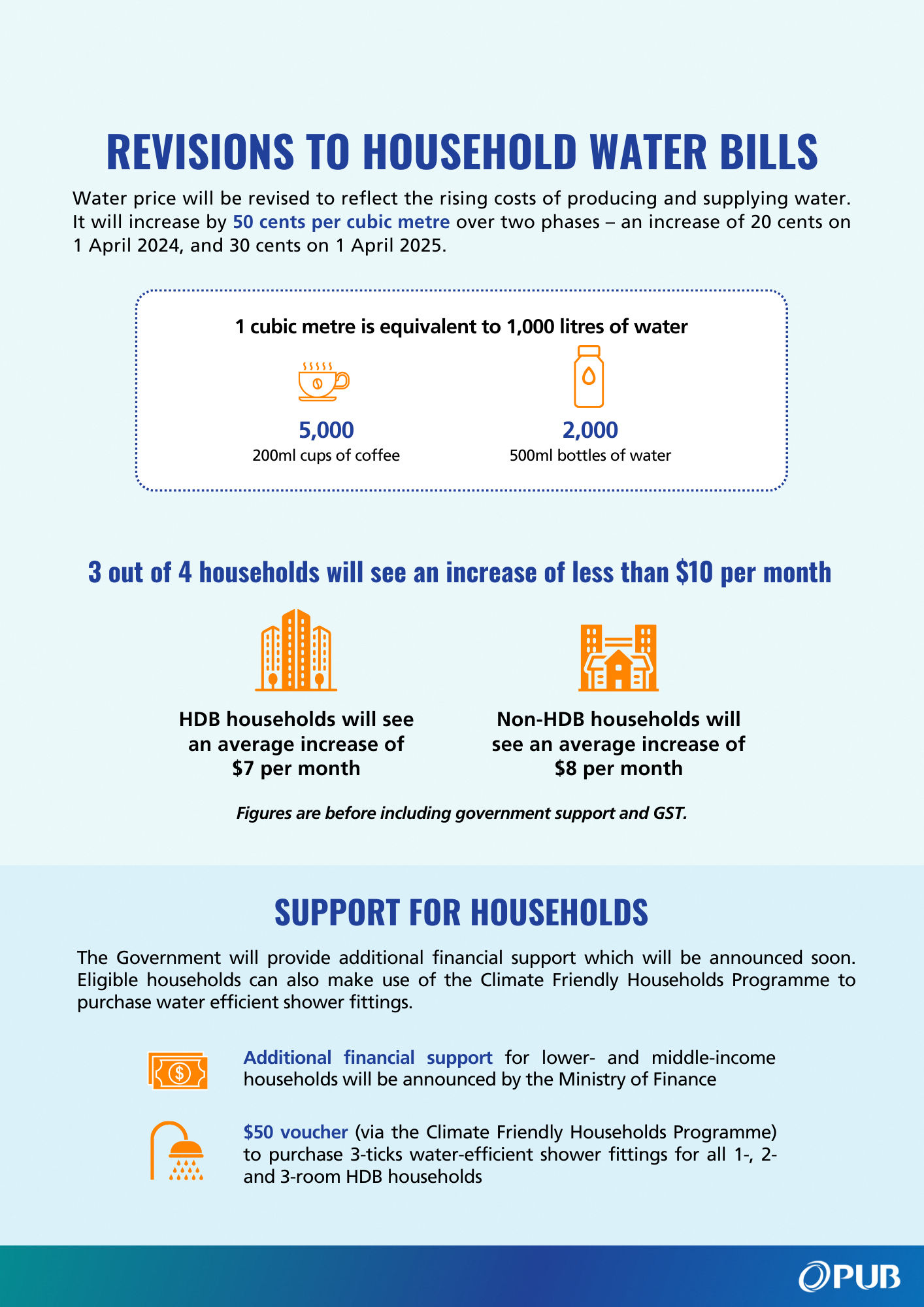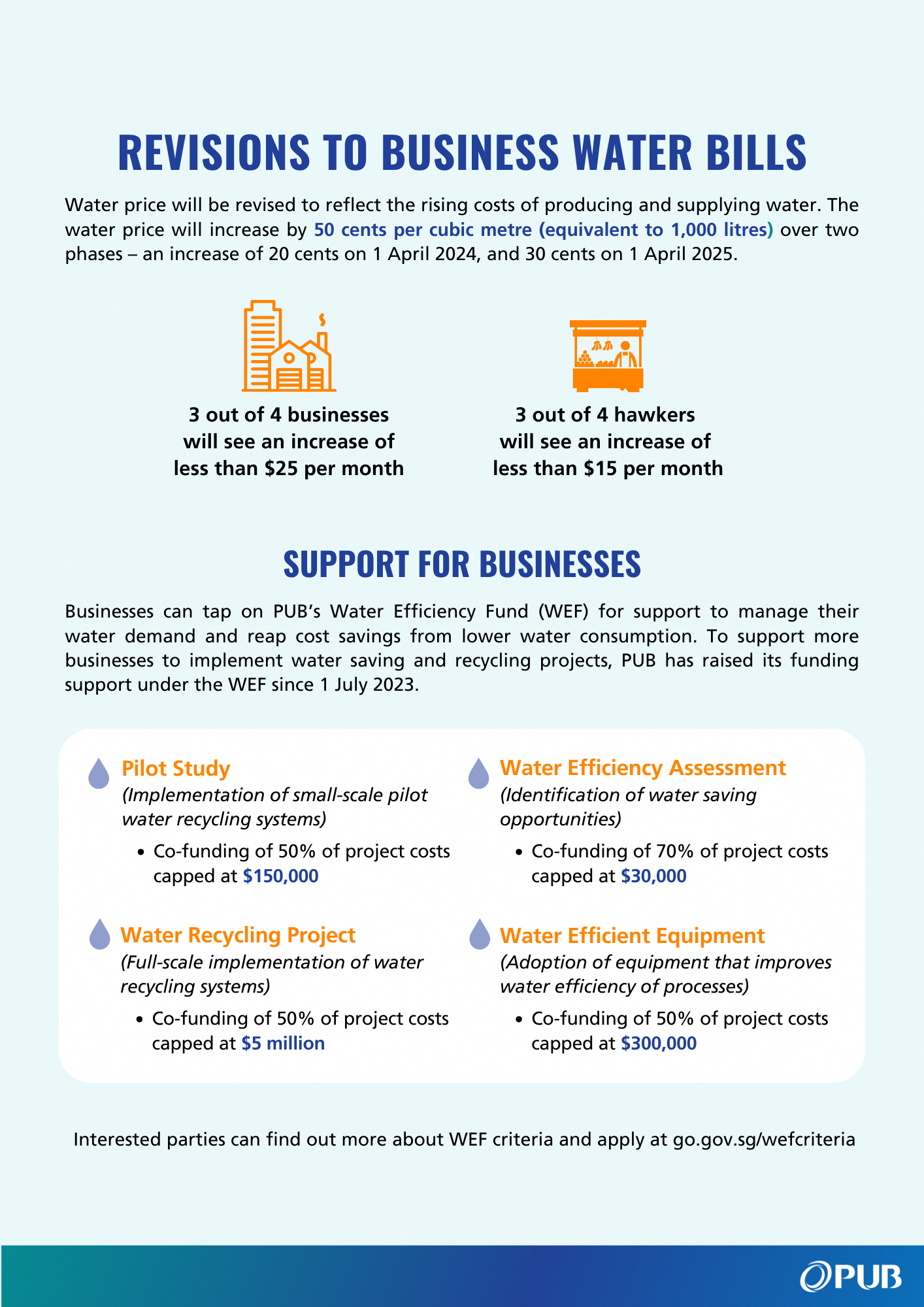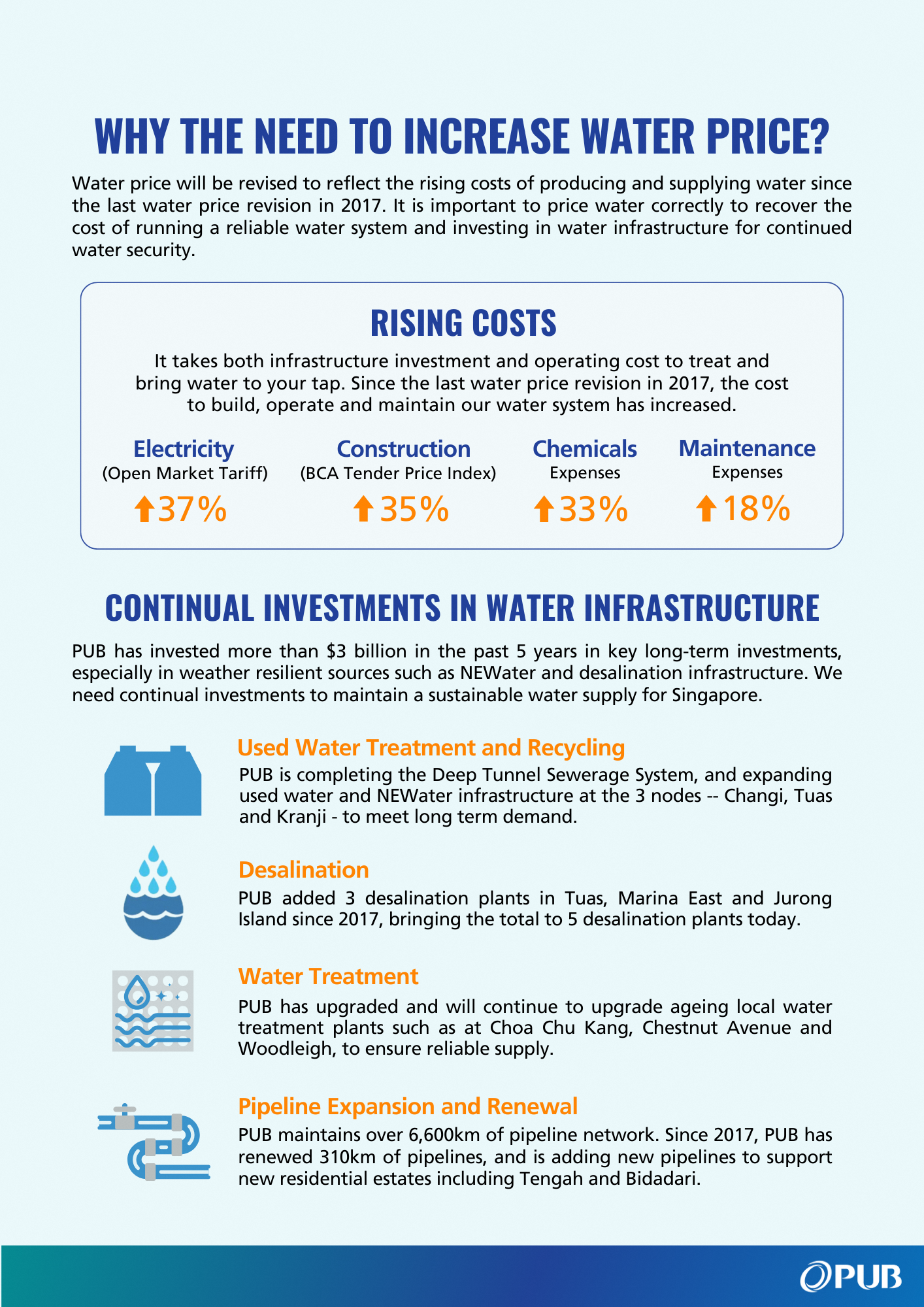
Singapore, 27 September 2023 – Water price will be revised in two phases on 1 April 2024 and 1 April 2025, to reflect the rising costs of producing and supplying water.
2. Water security is essential for Singapore. Water is a strategic resource that all of us – individuals, businesses, and the Government – must safeguard. Through long-term planning and continual investments in critical water infrastructure, Singapore has developed the Four National Taps1 to ensure a safe and reliable water supply to meet the needs of our population and economy. In Singapore, water is priced to recover the full cost of its supply and production, and to reflect the cost of producing the next drop of water. This right pricing of water also encourages water conservation by households and industries, to achieve a sustainable growth in water demand.
3. Even with active cost mitigation measures by PUB and our contractors, the cost of producing and supplying water has increased substantially since the last price revision in 2017, due to external cost pressures. Average electricity market tariffs have increased by about 37%, adding to PUB’s energy costs as we increasingly tap on energy-intensive sources such as NEWater and desalination to meet growing water demand. Construction costs in Singapore have also gone up by 35% across the industry2, with higher increases for specialised works PUB must undertake, such as tunnelling and pipeline projects through highly urbanised areas. PUB’s expenses for essential chemicals in water and used water treatment have increased by about 33%, due to inflationary pressures and supply chain disruptions. Similarly, maintenance expenses have risen by 18% due to higher manpower costs for contracted services.
4. Singapore’s water demand is projected to almost double by 2065 in tandem with economic and population growth. Climate change will also put greater strain on our local catchment and imported water which are weather-dependent. To ensure the security and sustainability of our water supply, we will need to maintain long-term investments in water infrastructure and further develop ourweather-resilient water sources such as NEWater and desalinated water, which are more energy-intensive and costlier to produce.
5. The current potable water price is set at $2.74 per cubic metre. To meet the higher costs of supplying and producing water, the potable water price will increase by 50 cents per cubic metre (equivalent to 1,000 litres of water). This will be implemented in two phases – an increase of 20 cents per cubic metre from 1 April 2024, and a further 30 cents per cubic metre from 1 April 2025. This would represent an increase in water price of about 2.5% per year since the last price revision. The phased approach, with a smaller increase in the first year, is intended to help households and businesses adjust to the price increase and allow more time for the adoption of water conservation measures. For NEWater customers, the NEWater price will increase by 17 cents per cubic metre, similarly carried out in two phases (Refer to Annex for details).
Support for Households and Businesses
6. With the full price revision implemented from April 2025, 3 in 4 households will see an increase of less than $10 in their monthly water bills, before government support. Similarly, 3 in 4 businesses (including small and medium enterprises) will see an increase of less than $25 in their monthly water bills. Water bills account for less than 2% of an average household’s expenditure3. For most businesses, their utilities bills – which include electricity, gas, and water – make up less than 5% of their business costs4.
Support measures for HDB households
7. The Government will provide additional financial support to help mitigate the impact of the water price increase and other cost of living concerns, especially for lower- and middle-income households. Details will be announced by the Ministry of Finance shortly. PUB will also work with the Ministry of Trade and Industry and relevant authorities to advise against profiteering by businesses.
8. All 1-, 2- and 3-room households can also apply for e-vouchers under the Climate Friendly Households (CFH) Programme5 , to offset the costs of purchasing water-efficient shower fittings. In the coming year, there will be enhancements to extend the programme to more water fittings to support water savings. Tapping on the CFH programme will help households to reduce water and energy consumption while benefitting from utility savings of around $50 to $150 per household annually.
Support for businesses to enhance water efficiency
9. Businesses may also tap on PUB’s recently enhanced Water Efficiency Fund which provides support for companies in implementing water efficiency projects6 . Businesses are encouraged to tap on the fund to implement water recycling and water-efficient systems and technologies. By doing so, companies can reduce their water demand and achieve sustained cost savings in their business operations.
[UPDATE]
On 28 September 2023, the Ministry of Finance (MOF) announced additional financial support for lower- to middle-income households to offset their utilities bills. Read MOF’s press release for more information.
Footnotes:
[1] The Four National Taps are local catchment water, imported water, reclaimed water (NEWater) and desalinated water.
[2] BCA Tender Price Index: https://www1.bca.gov.sg/docs/default-source/docs-corp-form/free-stats.pdf
[3] Based on the latest Household Expenditure Survey, 2017/2018 (Singstat).
[4] Based on MTI's Economic Survey of Singapore 2022
[5] The Climate Friendly Households Programme is a joint initiative by NEA and PUB. All 1-, 2- and 3-room HDB households can receive 3 separate e-vouchers to offset costs of energy- and water-efficient appliances. More information can be found here: https://www.climate-friendly-households.gov.sg/
[6] Since 1 July 2023, PUB has increased the funding cap for water recycling projects from S$1 million to S$5 million and the funding cap for the Industrial Water Solutions Demonstration Fund (IWSDF) from $4 to $5 million, In addition, the co-funding ratio for water efficiency assessments and pilot studies has been increased from 50% to 70%. More on enhancements to the Water Efficiency Fund to support water efficiency and sustainable water management among businesses can be found here:
https://www.pub.gov.sg/Resources/News-Room/PressReleases/2023/09/Water-price-to-rise-from-April-2024-Government-to-provide-support
Annex A
Phasing of Increase in Potable Water Prices for Domestic and Non-Domestic Users
| Domestic Potable Water Prices ($ per cubic metre) |
||||||||
|---|---|---|---|---|---|---|---|---|
| Current | From 1 April 2024 | From 1 April 2025 | ||||||
| 0 - 40m3 | >40m3 | 0 - 40m3 | >40m3 | 0 - 40m3 | >40m3 | |||
| Tariff | 1.21 | 1.52 | 1.29 | 1.63 | 1.43 | 1.81 | ||
| Water Conservation Tax (% of Tariff)* |
0.61 | 0.99 | 0.65 | 1.06 | 0.72 | 1.18 | ||
| Waterborne Tax | 0.92 | 1.18 | 1.00 | 1.25 | 1.09 | 1.40 | ||
| Total Price | 2.74 | 3.69 | 2.94 (+0.20) |
3.94 (+0.25) |
3.24 (+0.30) |
4.39 (+0.45) |
||
Note: All figures are before GST.
*Water Conservation Tax is applied at 50% of Tariff for domestic users consuming less than 40 cubic metres per month, and at a higher rate of 65% of Tariff for the volume in excess of 40 cubic metres per month. This higher Tariff and Water Conservation Tax, for volume in excess of 40 cubic metres per month, apply to about 4% of households today.
| Non-Domestic Potable Water Prices ($ per cubic metre) |
|||
|---|---|---|---|
| Current | From 1 April 2024 | From 1 April 2025 | |
| Tariff | 1.21 | 1.29 | 1.43 |
| Water Conservation Tax (% of Tariff) |
0.61 | 0.65 | 0.72 |
| Waterborne Tax | 0.92 | 1.00 | 1.09 |
| Total Price | 2.74 | 2.94 (+0.20) |
3.24 (+0.30) |
Note: All figures are before GST.
ANNEX B
Phasing of Increase in Waterborne Tax for NEWater
| NEWater ($ per cubic metre) |
|||
|---|---|---|---|
| Current | From 1 April 2024 | From 1 April 2025 | |
| Tariff | 1.28 | 1.28 | 1.28 |
| Water Conservation Tax | 0.13 (10% of Tariff) |
0.13 (10% of Tariff) |
0.13 (10% of Tariff) |
| Waterborne Tax | 0.92 | 1.00 | 1.09 |
| Total Price | 2.33 | 2.41 (+0.08) |
2.50 (+0.09) |
Note: All figures are before GST.
ANNEX C



ANNEX D
Continual Investments in Water Infrastructure
1. In the last five years, we have added three desalination plants in Tuas, Marina East and Jurong Island, bringing the total to five desalination plants today7. We are reconstructing Choa Chu Kang Waterworks, one of Singapore’s oldest water treatment plants, to enhance the plant’s operations, maintenance, safety, and security.
2. PUB is also investing in used water infrastructure to maximise water recycling and boost our capacity to produce NEWater. Changi Water Reclamation Plant (WRP) is undergoing a second phase of expansion, while Kranji Water Reclamation Plant (together with the Kranji NEWater plant) will be redeveloped by 2035 with higher treatment capacity. The new Tuas Water Reclamation Plant, which is a part of the Deep Tunnel Sewerage System (DTSS) phase 2 project, will be completed in 20268. We are also expanding our NEWater production capacities with the construction of a plant in Tuas, as well as a third plant located within Changi WRP9.
3. Besides producing and treating water, PUB operates and maintains a 6,600km network of pipelines that deliver water to 1.7 million customers. In 2022, PUB completed the 22km Murnane Pipeline to meet water demand in the city area. PUB will be adding several new potable water pipelines by 2030, to support growing demand in existing and new residential estates across Singapore, such as Tengah and Bidadari. These are critical investments that will strengthen our water security and resilience to cope with long term water challenges.
Footnotes:
[7] The five desalination plants are Jurong Island Desalination Plant (2022), Marina East Desalination Plant (2020), Tuas Desalination Plant (2018), Tuas South Desalination Plant (2013) and SingSpring Desalination Plant (2005).
[8] The DTSS is a major used water infrastructure that will boost water recycling and enhance Singapore’s long-term water sustainability.
[9] There are currently five NEWater plants. Two of the plants are located within Changi WRP, while the other three are in Bedok, Kranji and Ulu Pandan.

ANNEX E
Frequently Asked Questions
1. How is the $0.50/m3 increase in potable water price derived?
In Singapore, water is priced to recover the full cost of its supply and production, and to reflect the cost of producing the next drop of water, which will be from desalination and NEWater. The need for continued investment in water infrastructure, coupled with rising operational costs, have made the increase in water prices necessary.
The $0.50/m3 price increase refers to the total increase across all the components of the total water price, i.e. the water tariff, the Water Conservation Tax and Waterborne Tax. It is equivalent to about 2.5% increase per year since the last water price revision. The revision will be implemented in two phases, with a smaller increase in the first year, to help mitigate the impact of the price increase on customers. Right-pricing water allows us to continue investing ahead of time to ensure a secured and resilient water supply for current and future generations.
2. Can the price increase be deferred?
The total cost of producing and supplying water already exceeds today’s water price, due to external cost pressures over the past few years. To catch up to the rising costs and support continued investments, water price needs to be increased at this point. Deferring the increase will only mean higher, more significant hikes in the near future.
The price increase at this point will enable PUB to sustain its operations and maintain existing assets, to deliver high-quality and reliable water supply and used water services. It will also allow us to support critical investments in water infrastructure to ensure water security for Singapore, amidst the challenges of climate change and water demand growth.
3. Can we expect more frequent water price increases in the future?
We review the water price regularly, to ensure the right pricing of water. The need to revise the water price would take into consideration both annual operating costs as well as long-term investments in water infrastructure.
Our operating costs are affected by external factors, which we expect to remain elevated. PUB proactively implements cost management measures to manage the cost of producing and supplying water. Over the longer term, PUB is investing in Research and Development on new technology as well as process innovation to target our key cost drivers. These efforts serve to manage the growth in long-term costs on a sustainable trajectory, even as we need to renew and expand our water system.
Our long-term water infrastructure plans also affect the level of investments required. These plans are reviewed periodically, in line with updates to national projections for population and economic growth, as well as land use changes.
4. What is the average monthly household water usage?
The average household consumes about 15 cubic metres of water each month.
With the full price increase, the average HDB household will see an increase of $7 a month in water bill. The water bill also accounts for less than a third of the average utility bill, which includes electricity charges.
Please refer to the SP Services Website for a detailed breakdown of monthly water consumption by each household type (e.g. 1-room HDB, 2-room HDB, etc.)
5. Can there be differentiated pricing for lower-income households? What forms of support can households tap on to manage the increase in water bills?
In Singapore, our approach has been to ensure right pricing of water for everyone, but with targeted support for those who need it most.
To address cost-of-living concerns, the Government is currently providing support via the Assurance Package and the one-off Cost-of-Living special payments. These include U-Save rebates for eligible HDB households which can be used to offset utilities bills.
To help mitigate the impact of this water price increase and other cost of living concerns, the Government will provide additional financial support, especially for lower- and middle-income households. This will be announced by the Ministry of Finance shortly.
6. Are there any rebates for households who conserve water, or use less than the national average?
There are no rebates for households who consume below a certain volume. Water is priced to reflect that every drop is precious, and to encourage conservation. The amount households pay for water is based on the volume of water used. Therefore, those who use less, pay less. Households are encouraged to adopt water saving habits and enjoy savings in their water bills.
7. A higher water price applies to households with a monthly usage of more than 40 cubic metres. What is the proportion of households who fall under this category?
More than 96% of households use less than 40 cubic metres (m3) of water monthly. For the very small proportion of households which use more than 40m3 of water per month, they will pay a higher price for the volume of water consumed above 40m3. This 40m3 threshold accommodates most household needs and serves to discourage excessive use of water.
-End-